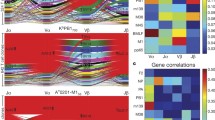Abstract
We analyzed nucleotide and deduced amino acid sequence heterogeneity of sheep T-cell receptor β-chain cDNAs isolated from an anchored-polymerase chain reaction library. Evaluation of 34 individual rearrangements has defined 18 new β-chain variable region sequences which have been clustered into 13 families. Presumptive allelic polymorphisms of four of these variable regions have been defined, as well as ten distinct β-chain joining region sequences. The present analysis indicates that sheep T-cell receptor β-chains are composed of characteristic leader, variable, joining, and constant region sequences, and that imprecise joining and N-region addition contribute significantly to diversity in the third hypervariable region. Thus, it appears that sheep, like all other mammals studied to date, employ somatic rearrangement of multiple germline genes to create β-chain heterogeneity. These findings have allowed us to estimate the diversity of the sheep T-cell receptor β-chain variable region repertoire, and they provide information that will permit the evaluation of the role that specific T-cell populations play in naturally occurring and experimental diseases of sheep.
Similar content being viewed by others
Author information
Authors and Affiliations
Additional information
Received: 20 October 1997 / Revised: 20 April 1998
Rights and permissions
About this article
Cite this article
Halsey, W., Palmer, B., DeMartini, J. et al. Analysis of sheep T-cell receptor β-chain heterogeneity. Immunogenetics 49, 206–214 (1999). https://doi.org/10.1007/s002510050481
Issue Date:
DOI: https://doi.org/10.1007/s002510050481




